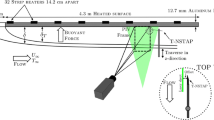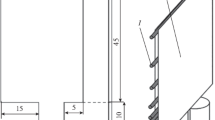Abstract
Previous work has shown that the k 2 term in the effective cooling velocity equation for inclined hot-wires can become negative under certain probe configurations and wire length-to-diameter ratios. It was hypothesised that this was due to a downwash component of velocity along the wire when prong interference effects were expected to be minimal. Direct measurements of the flow around a typical hot-wire probe using digital particle image velocimetry have shown that this downwash velocity component does exist, leading to negative values of k 2 as calculated from the angle of deviation from the free stream.
Similar content being viewed by others
Abbreviations
- d :
-
diameter of hot-wire mm
- k :
-
factor in equation for effective dimensionless velocity for inclined hot-wire
- l :
-
length of hot-wire mm
- Q :
-
effective velocity mm/s
- U :
-
free stream velocity mm/s
- α :
-
angle between free stream and degrees wire normal
- δ :
-
angle through which flow is degrees deflected at working section of wire
References
Adrian RJ (1991) Particle imaging techniques for fluid mechanics. Ann Rev Fluid Mech 23: 261–304
Adrian RJ; Johnson RE; Jones BG; Merati P; Tung AT-C (1984) Aerodynamic disturbances of hot-wire probes and directional sensitivity. J Phys E Sci Instrum 17: 62–71
Bremhorst K (1981) Effect of mounting systems on heat transfer from inclined cylinders in cross flow. Int J Heat Mass Transfer 24: 243–250
Champagne FH; Sleicher CA; Wehrmann OH (1967) Turbulence measurements with inclined hot-wires. Part 1. Heat transfer experiments with inclined hot-wire. J Fluid Mech 28: 153–175
Comte-Bellot G; Strohl A; Alcaraz E (1971) On aerodynamic disturbances caused by single hot-wire probes. Trans ASME J Appl Mech 38: 767–774
Hinze JO (1959) Turbulence. 1st ed., New York: McGraw Hill
Jorgensen FE (1971) Directional sensitivity of wire and fibre-film probes. Disa Information 11: 31–37
Soria J (1993) Particle image velocimetry. Proc. Workshop on Laser Diagnostics in Fluid Mechanics and Combustion, DSTO Aeronautical Research Laboratory, Melbourne, Australia
Welsh MC; Hourigan K; Welch LW; Downie RJ; Thomson MC; Stokes AN (1990) Acoustics and experimental methods: The influence of sound on flow and heat transfer. Exp Therm Fluid Sci 3: 138–152
Author information
Authors and Affiliations
Rights and permissions
About this article
Cite this article
Graham, L.J.W., Soria, J. & Bremhorst, K. Examination of the flow around a hot-wire probe using particle image velocimetry. Experiments in Fluids 19, 379–382 (1995). https://doi.org/10.1007/BF00190254
Received:
Accepted:
Issue Date:
DOI: https://doi.org/10.1007/BF00190254




